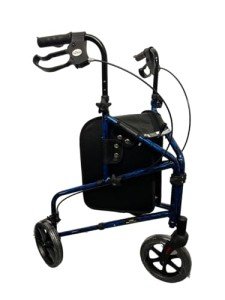
Durable Walker
FollowOverview
-
Founded Date March 20, 1996
-
Sectors Child day-care activities
-
Posted Jobs 0
-
Viewed 39
Company Description
10 Things You Learned From Kindergarden Which Will Aid You In Obtaining How To Use A Rollator

How To Use A Rollator: A Comprehensive Guide
Rollators are mobility aids developed to improve the independence and safety of people with mobility obstacles. Unlike basic walkers, rollators are geared up with wheels, a seat, and often a storage pouch, allowing users to move with higher ease and comfort. This article provides an in-depth guide on how to use a rollator effectively and securely, guaranteeing a smoother and more enjoyable walking experience.

What is a Rollator?
A rollator is a wheeled walking aid. It generally has:
- Three or four wheels: Offering stability and maneuverability.
- Hand brakes: For control while walking or when resting.
- A seat: Allowing users to take breaks easily.
- Storage area: Such as a basket or pouch for individual products.
Types of Rollators
There are various types of rollators, designed to meet the requirements of different users:
| Type | Description | Best for |
|---|---|---|
| 3-Wheel Rollator | Lighter and more compact, ideal for indoor use | Browsing tight areas |
| Red 4-Wheel Rollator with Seat by HOMCOM Rollator | Offers stability and a bigger seat, appropriate for outdoor use | Longer strolls and much heavier use |
| Heavy-Duty Rollator | Developed to support more weight with extra robust features | Users needing additional assistance |
| Pediatric Rollator | Smaller sized in size, adjusted for children | Children with mobility limitations |
How to Use a Rollator
Using a rollator properly is important to guarantee safety and maximize the benefits it uses. Here’s a step-by-step guide:
Step 1: Adjust the Height
Before using the rollator, it is important to adjust the handlebars to the right height.
- Stand straight: With your arms unwinded at your sides.
- Step the height: The hand grips need to be at wrist level when the user is standing.
- Safe modifications: Ensure all locking systems are strongly engaged.
Action 2: Familiarize Yourself with the Rollator
Comprehending the elements of the rollator will help boost its usability.
- Brakes: Learn how to engage and release the brakes by squeezing the deals with.
- Seat: Identify where to sit conveniently when you need to rest.
- Storage area: Know where you can save personal valuables.
Step 3: Start Walking
- Position the rollator: Place it an action ahead of you, making sure that the brakes are released.
- Grip the manages securely: Keep a light stress in your arms while keeping the Stylish Rollator.
- Step inside the frame: Move forward by stepping with one foot and after that the other.
- Maintain a straight posture: Walking should be upright, avoiding the temptation to lean on the rollator exceedingly.
Step 4: Utilize Brakes
Always use the brakes efficiently to improve safety:
- To slow down: Gradually squeeze the brakes.
- To stop: Fully engage the brakes by pulling on both manages.
- To take a seat: Ensure the rollator is stable, then carefully lower yourself onto the seat.
Step 5: Maneuver with Care
Turning and navigating can be challenging, so here are important suggestions:
- Telegraph your instructions: Look where you want to precede turning.
- Take little actions: Move gently when turning to keep balance.
- Use a three-point turn: Turn from one side to the other, keeping the Helavo Foldable Walker with Seat for Easy Mobility close.
Action 6: Practice Stopping and Resting
Taking breaks is important. Here are suggestions for resting:
- Find flat surface areas: Ensure the area is level when you sit.
- Engage the brakes when seated: This will avoid rolling.
- Shift position slowly: When ready to stand once again, eliminate the brakes before increasing.
Upkeep and Safety Tips
To guarantee the rollator stays functional and safe:
- Regularly check the brakes: Ensure they engage and launch properly.
- Inspect wheel alignment: Wheels should not wobble; tighten up any loose screws.
- Tidy the rollator: Wipe down surface areas and eliminate debris from tires to maintain smooth operation.
Common Concerns
Users might deal Helavo Foldable Walker with Seat for Seniors a number of typical problems when utilizing rollators. Here are some general FAQs:
FAQs
Q1: Can I use a rollator outdoors?A: Yes, most
rollators are created for both indoor and outdoor use. However, guarantee it has the suitable wheel size and tread for outdoor surface areas. Q2: What are the weight limits on rollators?A: Weight restricts
generally vary by model, but heavy-duty rollators can normally accommodate users weighing around 300 to 500 pounds. Q3: Are rollators adjustable?A: Yes, a lot of rollators feature adjustable deal with heights to accommodate users of numerous heights
. Q4: How do I transfer a rollator?A: Many rollators canbe folded for convenient transportation in a car. Constantly check the user handbook for specific folding instructions. Q5: Can I use a rollator while recovering from surgery?A: Yes, numerous individuals use rollators throughout recovery to gain back strength and balance, but ensure you follow your health care supplier’s suggestions.
Comprehending how to use a rollator properly can substantially improve mobility and decrease the danger of falls. Whether you are brand-new to utilizing mobility aids or looking to fine-tune your method, following the guidelines talked about in this article is crucial. With practice, a rollator can boost self-reliance while ensuring safety, thus enabling users to take pleasure in a more active lifestyle.
